Horticultural Therapy
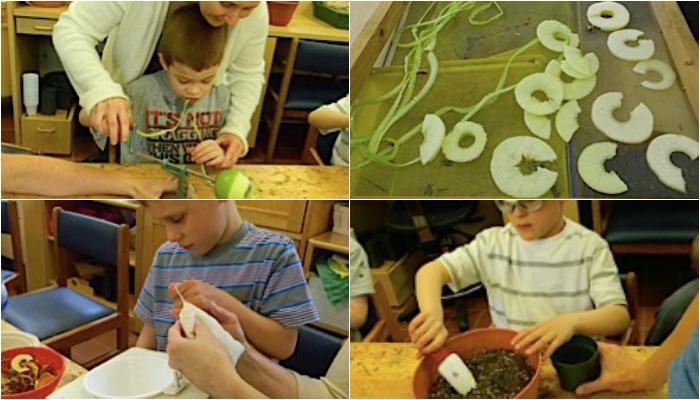
This post may contain affiliate links; please see our terms of use for details.
Horticultural Therapy (also called Horticulture Therapy or Gardening Therapy) is the simple idea that people with disabilities can learn and prosper by being in the garden and working with plants.
It’s not really surprising if you think about it: Gardens and greenhouses are very soothing places with a lot of opportunities for sensory stimulation that isn’t too overwhelming.
The sound of a light water fountain, the smell of mint leaves and the feel of a waxy leaf are all great sensory input, but still relaxing and easy to take in. Horticultural Therapy can be an especially positive experience for children who are blind or visually impaired.
What Can You Learn in the Garden?
There are a lot of things that your child could learn through Horticultural Therapy. Some of the things to focus on might be:
- Hygiene: Be sure to wash your hands before you start working with your plants so that you don’t bring in fungus or viruses. While playing in the dirt you can talk about the difference between clean and dirty and then wash your hands again when you’re done. What a great real-world opportunity to get in some talk about hygiene!
- Textures: Check out how different plants have different textures. Feel the difference between a smooth apple and a bumpy orange.
- Smells: Be sure to plant lots of herbs. They grow fast, are easy to cultivate and smell wonderful when crushed! Mint and basil are two fun plants with lots of fragrance.
- Tastes: There are actually a lot of things in the garden that you can put in your mouth, so for kids who are into mouthing things, let them go for it! Give them projects involving fruits, vegetables and herbs so they can taste what they are working with.
- Fine Motor Skills: The greenhouse is the perfect place for pulling weeds, crunching up dried leaves or squeezing a water bottle, all great hand skills!
- Counting: Count the petals on a flower or the number of seeds on the table. See if you can guess how many shovels of dirt it takes to fill up a pot.
- Wet & Dry: Be sure to have your child help with the watering too! Talk about how the dirt is dry before it is watered and then… it’s wet!
- Taking Turns: Take turns dropping seeds into the holes or shoveling dirt into a pot. Learning to share is a really important skill!
But how do you bring this all together into a gardening project? Below are four ideas from the Perkins School for the Blind Horticultural Program. I’m sure you can think of lots of other fun activities, too!
Project #1: Dried Apple Rings
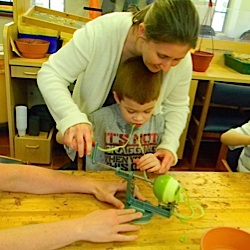 What You’ll Need
What You’ll Need
- Ripe (but firm) apples
- An apple peeler with a turn crank
- A food dehydrator (either electric or with trays)
- Lemon juice or cinnamon (optional)
Placing an apple in an apple peeler and turning the crank is so much fun! With just that simple turn of the handle you can feel the skin come off the apple and then it slices and cores the apple, too! Once your child gets the hang of how this works you’ll end up peeling and coring a bag full of apples before you know what’s happened!
Once your apple is sliced you can dip it in lemon juice or sprinkle with cinnamon. This allows you to add more flavors and smells to your project.
Lay your apple slices on the dehydrating tray and follow directions for drying fruit. When your fruit is dry, you can eat them or use them in another project!
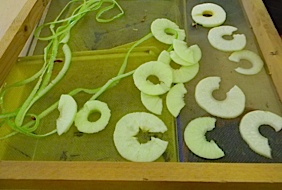
Project #2: Planting Sunflower Seeds
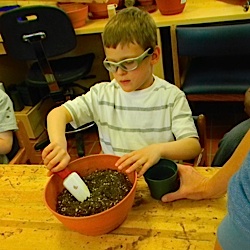 What You’ll Need
What You’ll Need
- A big pot with potting soil
- Smaller pots to grow your plants in
- Small plastic shovel
- Sunflower seeds
- Watering can
Since you’ll be working with dirt, this is a good project for children who don’t have to put everything in their mouths and are OK with getting their hands a little dirty.
All you need to do is shovel the potting soil into each of the small pots then place a sunflower seed in the pot. Cover up the seed with soil and then water with your watering can.
I know it sounds simple, but it’s actually really fun! You can count your pots and count your seeds, talk about how deep a seed should be planted and sing songs about the rain while you water. Plus it’s so exciting when the seeds begin to pop up out of the soil!
Project #3: Making Scented Sachets
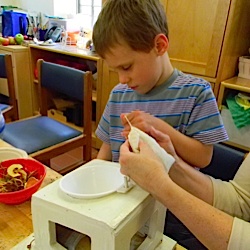 What You’ll Need
What You’ll Need
- Muslin drawstring bags
- Dried herbs and spices (preferably ones you’ve grown yourself)
- A funnel
This is another deceptively simple project. All you need to do is fill your bag with the scented herbs and spices, pull the drawstring closed and you’re done!
But if you grow and dry your own herbs, then this becomes a much bigger project. Sage, for example, is very easy to grow and dries with a lovely smell. You can have your child crunch the leaves in a bowl to turn them into a kind of powder, then fill his bag with the powdered sage he grew himself! That’d be a nice gift for grandma, wouldn’t it?
At Perkins they’ve made an ingenious little table out of cardboard that holds the funnel and bag on the left and a bowl on the right so that it’s easy for kids to fill their sachets. Watch the video below to see a student count out dried apples (from their fruit drying project the week before) and place handfulls in the funnel:
Project #4: Making Tea
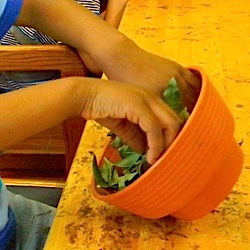 What You’ll Need
What You’ll Need
- Tea filter bags
- Dried herbs and spices (preferably ones you’ve grown yourself)
- A toilet paper roll cut in half
Here is another fun project for all those herbs you’ve been growing and drying. All you need to do is take your tea filter bag and place it inside the toilet paper roll, letting the edges hang over the sides. Have your child help crush up the herbs in a bowl until they are fine, but not too powdery (like loose tea).
Then place the dried herbs in the tea bags and you’ve got yourself tea! Mint makes great tea (and is also easy to grow) and so does dried fruit. How about using some of those dried apples and throwing in some cloves? Yum!
More Resources
Looking for more information about Horticultural Therapy? Check out these links:
- An article about horticulture therapy at Perkins School for the Blind
- American Horticultural Therapy Association
- Horticultural Therapy Institute
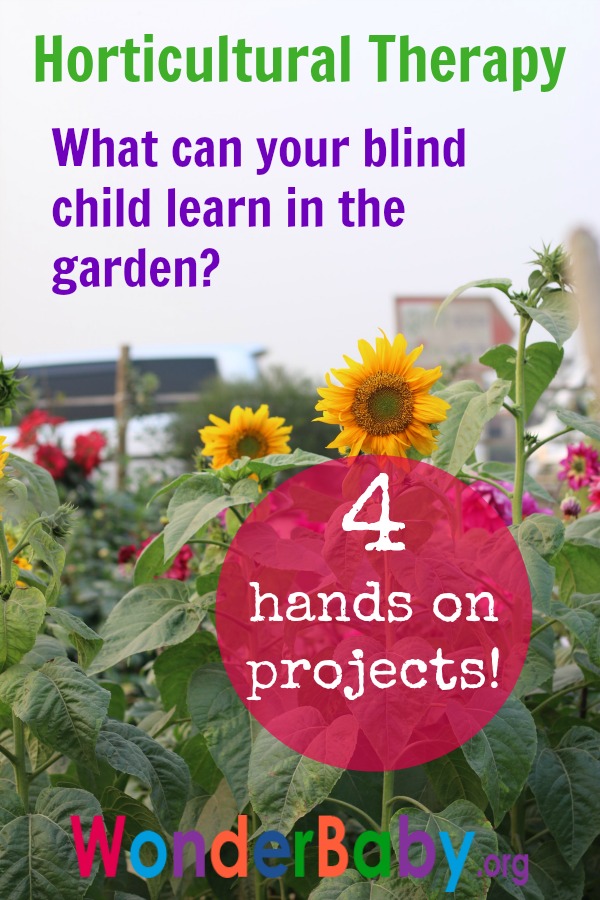
Related Posts
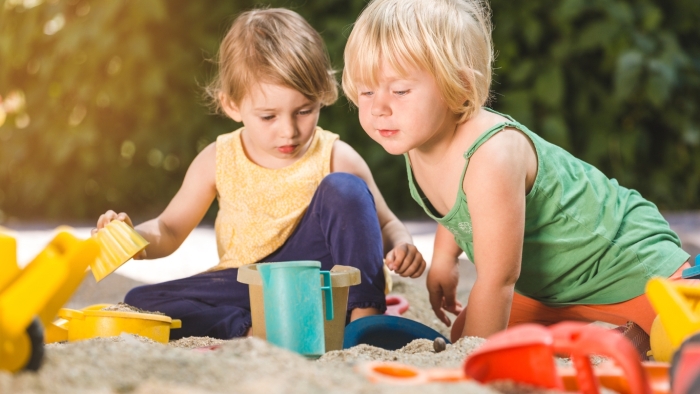
Sensory Activities
5 Sand Play Activities to Encourage Fine Motor Development
Sensory bin, at the beach, or in a sandpit? Try these sand play activities to help toddlers and preschoolers develop their fine motor skills.
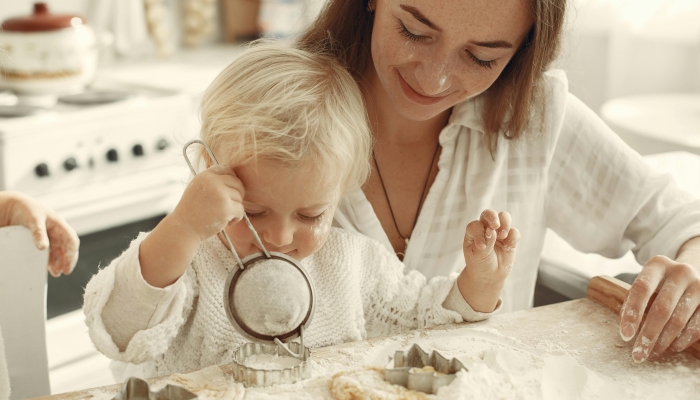
Sensory Activities
5 Edible Sensory Play Ideas
Check out our favorite edible sensory play activities to engage children's senses, boost their development, and provide hours of fun.

Sensory Activities
How to Make Unpoppable Bubbles
Discover the secret to making unpoppable bubbles with this easy guide. You only need three ingredients!